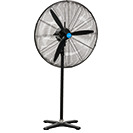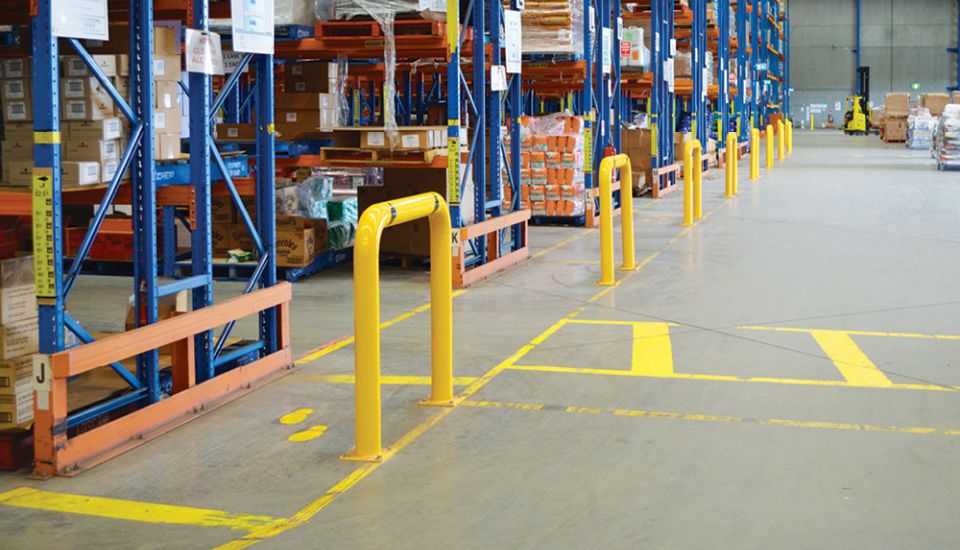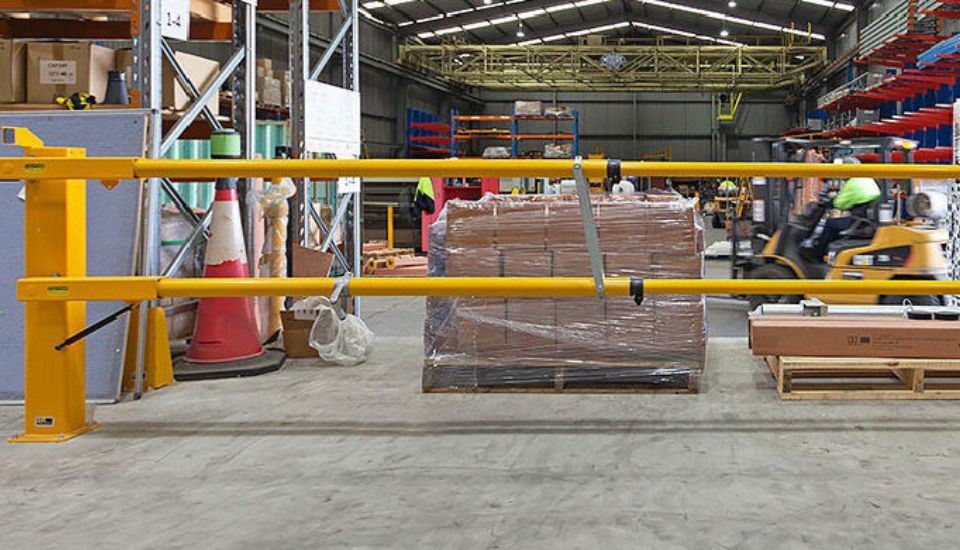5 Core Functions of Safety Barriers in a Warehouse
Date Posted:29 September 2025
From preventing forklift impacts to guiding traffic, explore these essential safety barrier functions for warehouse protection. Keep your operations safe, organised, and efficient.
Verdex Insights: At a Glance
-
The Challenge: Frequent forklift traffic, tight storage areas, and heavy machinery create ongoing risks of damage to warehouse inventory and infrastructure. Uncontrolled movement and poor layout can lead to costly repairs, downtime, and safety breaches.
-
The Insight: Installing quality safety barriers helps absorb impacts, protect racking and equipment, and organise vehicle and pedestrian traffic. Barriers improve workplace safety while reducing maintenance costs and operational disruptions.
-
The Verdex Solution: Verdex supplies high-capacity safety barriers, bollards, and protection systems engineered for warehousing, logistics, and manufacturing environments. Our durable barrier solutions help businesses protect assets, maintain productivity, and stay WHS compliant.
How Safety Barriers Help Prevent Damage to Inventory and Infrastructure
In a warehouse or distribution centre, the daily movement of goods and equipment can present numerous risks, including damage to valuable inventory and infrastructure.
With forklifts, pallet jacks, and other heavy machinery frequently navigating tight spaces, accidents are inevitable unless effective safeguards are in place. This is why many businesses turn to trusted providers like Verdex for complete warehouse safety and material handling equipment solutions.
These simple yet effective tools can make all the difference in reducing damage to both the assets and infrastructure of a warehouse. Let’s explore how safety barriers help in preventing costly damages and improving overall operational safety.
5 Core Functions of Safety Barriers in a Warehouse
A safety barrier is a physical structure designed to protect workers, equipment, and inventory from accidents and impacts. They serve as a deterrent to the movement of machinery or personnel into high-risk zones and act as protective barriers around critical infrastructure. Their primary function is to delineate areas, prevent accidents, and minimise the potential for damage caused by collisions, heavy traffic, and uncontrolled movements.
In warehouse environments, these barriers are strategically placed around machinery, shelves, storage areas, and entryways. They protect not only the physical integrity of the warehouse but also ensure that valuable inventory, machinery, and structures are shielded from accidental damage. Safety barriers work best when combined with other workplace safety equipment, creating a complete system of protection.
1. Protecting Inventory from Forklift and Vehicle Collisions
Forklifts are the backbone of warehouse operations, responsible for moving goods in and out of storage areas. However, the sheer size and weight of forklifts make them a significant hazard when navigating through tight aisles or around high-stacked shelves. A sudden collision between a forklift and an inventory rack or an item of stock can cause significant damage, leading to costly losses.
How Safety Barriers Help:
-
Prevent Direct Impact: Heavy-duty steel barriers or plastic safety barriers placed around shelving units or storage racks help to absorb the impact of forklift collisions. These barriers act as buffers, preventing forklifts from directly striking the inventory. This reduces the likelihood of damage to goods, particularly fragile items.
-
Delineating Safe Zones: Barriers help define safe zones for employees to operate within, keeping them clear of high-risk areas where forklifts and other heavy machinery are frequently used. This reduces the chances of accidental inventory damage from workers being in the wrong place at the wrong time.
-
Preserving Inventory Integrity: For high-value inventory, using barriers can significantly reduce the risk of items being knocked over, damaged, or displaced by machinery, ensuring products remain in good condition.
2. Reducing Damage to Warehouse Infrastructure
In addition to protecting inventory, warehouses often house valuable infrastructure such as loading docks, machines, and storage systems. Collisions with walls, doors, or shelving units can result in costly repairs and downtime. Steel barriers, bollards, and mesh barriers are vital in protecting this infrastructure from impacts caused by vehicles and equipment. Our range of safety barriers and security bollards ensures you can match the right solution to each risk area.
How Safety Barriers Help:
-
Prevent Structural Damage: Bollards and steel barriers are commonly used to protect warehouse walls, doorways, and other vital infrastructure. Their robust construction helps absorb the force of vehicle collisions, reducing the risk of damage to the building's structure.
-
Protecting Loading Docks and Ramps: Loading docks are a high-traffic area, and accidents such as forklifts missing the dock or colliding with the edges can lead to significant infrastructure damage. Installing barriers around the dock edge and ramp ensures that forklifts and vehicles are guided safely into position, preventing potential damage.
-
Safeguarding Electrical and Mechanical Equipment: Equipment like electrical panels, HVAC systems, and water pipes are often installed close to high-traffic areas. By using barriers, these critical assets are shielded from accidental impact, avoiding service interruptions or the cost of repairs.
3. Improving Traffic Flow and Reducing Congestion
A common cause of damage in warehouses is the result of traffic congestion. When forklifts, trolleys, and personnel move in a disorganised or chaotic manner, the likelihood of collisions increases. Safety barriers play a key role in improving the overall flow of traffic, reducing the risk of accidents, and consequently, minimising damage.
How Safety Barriers Help:
-
Organising Pedestrian and Vehicle Traffic: By clearly marking pedestrian walkways and vehicle lanes with barriers, supported by workplace safety signage, warehouses can create a safer, more efficient traffic flow and reducing the risk of collisions. This is especially important in busy warehouse environments where both forklifts and people need to coexist safely.
-
Guiding Forklift Movements: Safety barriers, especially retractable ones, can be used to control forklift traffic and guide their movement. By restricting access to certain areas, these barriers help in managing traffic flow and ensure that vehicles don’t stray into inventory zones or delicate infrastructure areas.
-
Reducing Bottlenecks and Clutter: Installing barriers around busy areas can help streamline the movement of goods and machinery, reducing the likelihood of traffic jams and delays that can lead to accidents and, ultimately, damage to goods or infrastructure.
4. Shielding Hazardous Areas and Materials
Some areas in a warehouse are more hazardous than others. For example, zones containing heavy machinery, electrical equipment, or hazardous materials require additional safety measures. Safety barriers can be used to physically block access to these high-risk zones, ensuring that personnel and equipment stay out of harm’s way and preventing accidental damage.
How Safety Barriers Help:
-
Preventing Access to Dangerous Zones: Areas like chemical storage zones or machinery rooms should be clearly marked with barriers to prevent employees from entering. These barriers also serve to protect these areas from external damage caused by forklifts, trolleys, or other vehicles.
-
Containing Spills and Leaks: In areas where hazardous materials or liquids are stored, barriers can help contain any potential spills, preventing contamination of the surrounding environment. Equipping these areas with spill kits and workplace first aid kits provides an extra layer of preparedness.
-
Reducing Worker Exposure to Risks: When workers know they are protected by barriers, PPE, and clear processes, they feel safer and more confident. Ensuring employees have access to PPE clothing and safety gear alongside well-placed barriers further boosts morale and safety.
5. Minimising Maintenance and Repair Costs
Accidental damage to inventory and infrastructure leads to expensive repairs and maintenance. Whether it’s repairing damaged shelving or replacing broken items, these costs can add up quickly, eating into the warehouse's profits. Safety barriers offer a cost-effective solution for minimising these repair and maintenance costs.
How Safety Barriers Help:
-
Reducing Collision Frequency: By preventing unnecessary collisions, safety barriers reduce the need for costly repairs to both inventory and infrastructure. For example, heavy-duty barriers around shelves and racks can help protect them from forklift impacts, ensuring that inventory remains intact and the infrastructure remains in good condition.
-
Increasing Longevity of Equipment and Racks: Properly installed safety barriers can extend the lifespan of equipment and shelving units by reducing the frequency of impacts, which means fewer repairs or replacements over time.
-
Lowering Operational Downtime: When infrastructure is damaged, it can cause disruptions in the warehouse’s operations, leading to delays and downtime. By using safety barriers, the likelihood of such disruptions is reduced, improving productivity and minimising downtime.
Enhance Protection and Reduce Costs with Safety Barriers
Warehouse safety barriers are an essential part of a comprehensive safety plan. They not only prevent damage to inventory and infrastructure but also create a safer, more organised environment that fosters better traffic flow and reduces operational risks. Whether it's preventing forklift collisions with high-value inventory, protecting critical infrastructure from vehicle impacts, or reducing maintenance costs, safety barriers are a cost-effective and efficient solution for warehouse managers.
By investing in the right type of safety barriers for your warehouse, you can minimise the risk of accidents, protect valuable assets, and ensure smooth and safe operations. In the long run, the benefits of these safety barriers far outweigh the cost of installing them, making them a wise investment for any warehouse or distribution centre.
Get in Touch with Verdex Today
At Verdex, we’re committed to helping businesses protect their people, inventory, and infrastructure with reliable safety solutions. Whether you need safety barriers, warehouse protection systems, or tailored workplace safety equipment, our team can help you find the right solution.
-
Email us at sales@verdex.com.au
-
Or fill out our online contact form to get started
Take the next step toward a safer, more efficient workplace with Verdex.
































































































































 Trolleys & Hand Trucks
Trolleys & Hand Trucks Cage Trolleys
Cage Trolleys Cleaning Carts & Trolleys
Cleaning Carts & Trolleys Construction Trolleys
Construction Trolleys Custom Trolleys
Custom Trolleys Hand Trucks & Dollies
Hand Trucks & Dollies Laundry/Linen Trolleys
Laundry/Linen Trolleys Lifting Trolleys
Lifting Trolleys Order Picking Trolleys
Order Picking Trolleys Panel Cart Trolleys
Panel Cart Trolleys Platform Trolleys
Platform Trolleys Powered Trolleys
Powered Trolleys Shelf & Tiered Trolleys
Shelf & Tiered Trolleys Shopping Trolleys
Shopping Trolleys Stainless Steel Trolleys
Stainless Steel Trolleys Tool Trolleys
Tool Trolleys Utility & Service Carts
Utility & Service Carts Lifting & Handling Equipment
Lifting & Handling Equipment Forklift Attachments
Forklift Attachments Jib Attachments
Jib Attachments Lifting Hoists & Pallet Hooks
Lifting Hoists & Pallet Hooks Load Skates & Tow Tugs
Load Skates & Tow Tugs Manual Stackers & Lifters
Manual Stackers & Lifters Pallet Jacks
Pallet Jacks Pallet Lifters
Pallet Lifters Pallet Rotators & Dispenser
Pallet Rotators & Dispenser Powered Pallet Trucks & Electric Lifters
Powered Pallet Trucks & Electric Lifters Scissor Lift Trolleys and Tables
Scissor Lift Trolleys and Tables Conveyor Equipment
Conveyor Equipment Conveyor Frames & Stands
Conveyor Frames & Stands Roller & Skate Conveyors
Roller & Skate Conveyors Ladders & Access Equipment
Ladders & Access Equipment Container & Yard Ramps
Container & Yard Ramps Ladders & Step Stools
Ladders & Step Stools Work Platforms & Crane Cages
Work Platforms & Crane Cages Drum Handling Equipment
Drum Handling Equipment Drum Storage & Bunding
Drum Storage & Bunding Drum Trolleys & Lifters
Drum Trolleys & Lifters Forklift Drum Handling
Forklift Drum Handling Waste Handling & Bins
Waste Handling & Bins Bin Lifters & Tippers
Bin Lifters & Tippers Plastic Waste & Wheelie Bins
Plastic Waste & Wheelie Bins Steel Waste & Tipping Bins
Steel Waste & Tipping Bins Waste Carts
Waste Carts Dangerous Goods Storage & Spillage
Dangerous Goods Storage & Spillage Aerosol Cans Storage Cages
Aerosol Cans Storage Cages Bunded Pallets & Storage
Bunded Pallets & Storage Corrosive Goods Storage Cabinets
Corrosive Goods Storage Cabinets DG Storage & Trolleys
DG Storage & Trolleys Flammable Liquid Cabinets
Flammable Liquid Cabinets Forklift Gas Storage Cages
Forklift Gas Storage Cages Site Storage
Site Storage Spill Kits
Spill Kits Shelving & Storage Equipment
Shelving & Storage Equipment Stillage & Transport Cages
Stillage & Transport Cages 750 Series Cage Configurations
750 Series Cage Configurations Heavy Duty Cabinets
Heavy Duty Cabinets Heavy Duty Shelving
Heavy Duty Shelving Mega Bins & Pallets
Mega Bins & Pallets Packing & Workbenches
Packing & Workbenches Parts Trays & Stor-Pak Bins
Parts Trays & Stor-Pak Bins Pegboard & Louvre Panels
Pegboard & Louvre Panels Plastic Bins & Crates
Plastic Bins & Crates Plastic Handling Solutions Bins
Plastic Handling Solutions Bins Plastic Pallets
Plastic Pallets Stack & Nest Bins
Stack & Nest Bins Pallet Racking Accessories
Pallet Racking Accessories Workplace Equipment
Workplace Equipment Modular Workbenches
Modular Workbenches Electric Height-Adjustable Workbenches
Electric Height-Adjustable Workbenches Floor Matting
Floor Matting General Workplace Equipment
General Workplace Equipment Industrial Weighing Scales
Industrial Weighing Scales Packaging Machinery
Packaging Machinery Stationery Cupboards
Stationery Cupboards Storage and Stillage Cages
Storage and Stillage Cages Tool Trolleys
Tool Trolleys Tooling Cabinets
Tooling Cabinets Workshop Fans and Coolers
Workshop Fans and Coolers Safety Barriers, PPE & Signage
Safety Barriers, PPE & Signage Barriers & Bollards
Barriers & Bollards First Aid Equipment
First Aid Equipment Gloves, Knives and PPE
Gloves, Knives and PPE Signage
Signage Cleaning & Site Supplies
Cleaning & Site Supplies Cleaning Equipment
Cleaning Equipment Cleaning Trolleys
Cleaning Trolleys Rubbish Bins
Rubbish Bins Signs & Traffic Supplies
Signs & Traffic Supplies Construction Equipment
Construction Equipment Construction Trolleys
Construction Trolleys Waste Handling
Waste Handling General Site Equipment
General Site Equipment Concrete Equipment
Concrete Equipment Site Storage
Site Storage Lifting Equipment
Lifting Equipment Verdex Specials
Verdex Specials











